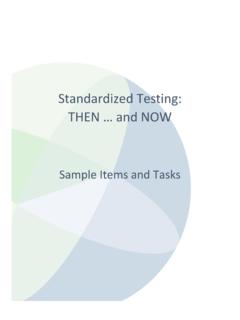Transcription of Quicksand: A Lightweight Implementation of …
1 Quicksand: A Lightweight Implementation ofProbabilistic programming forProcedural modeling and DesignDaniel RitchieStanford IntroductionThe past several years have seen the development of multiple probabilistic programming languages(PPLs) in the artificial intelligence community [9, 5, 12, 13, 7, 11]. In addition to their expres-siveness, PPLs allow programmers to develop models modularly and independently from inferencealgorithms. Over the same period, computer graphics research has begun to demonstrate how prob-abilistic inference can enable complex procedural content creation [6, 14, 18]. But this work hasrelied on specialized models and inference algorithms, making the methods difficult for technicalartists who possess programming skills but not necessarily inference expertise to adopt. Usingprobabilistic programming for procedural content creation has the potential to close this applications demand high performance, so a procedural content design PPL should com-pile to efficient machine code.
2 Tracing JIT compilers such as Shred can deliver high performance,but they suffer from excessive re-compilation overhead when programs exhibit extensive structurechange (which procedural modeling programs typically do) [17]. Instead, we asked: why not embedprobabilistic programming directly in a compiled, statically-typed, high-performance language?Along these lines, we present quicksand , a probabilistic programming system embedded in the Terrahigh-performance computing language [4]. We chose Terra as an embedding target because: Terra s multi-stage code generation simplified the embedding process quicksand is justa library in Terra, not a language extension. Terra is tightly integrated with Lua, a language already used for scripting in many statically-typed PPLs exist, but do not meet our goals. Figaro uses Scala s static type systemto assemble type-correct programs, but it incurs performance overhead by running on the JVM [13].
3 probabilistic C compiles directly to machine code, but it only supports forward inference methodsbased on Sequential Monte Carlo [11]. In contrast, quicksand produces efficient machine codeand supports a variety of Markov Chain Monte Carlo methods via its Lightweight embedding strat-egy [16]. This paper introduces the programming model and Implementation strategies programming in QuicksandFigure 1 shows some example quicksand programs. While quicksand was motivated by proceduralmodeling and design, it is general enough to express classical machine learning problems as instance, Figure 1 Left is an Implementation of the Bayesian linear regression model from the1qs = ("qs")-- Model definitionlinreg = (function()return terra()5-- The datavar xs = array( , , , )var ys = array( , , , )-- Parametersvar m = ( , , {struc=false})10var b = ( , , {struc=false})var v = ( , , {struc=false})-- Condition on all the provided datafor i=0,4 (ys[i], m*xs[i]+b, v)15end-- Predict the value at x=4return m* + bendend)20-- Query the model for the MAP predictionqueryfn = (linreg, , ( ()))print(queryfn())-- output: 1: quicksand example programs.
4 (Left)Code for Bayesian linear regression.(Right)Procedurally-generated spaceships (see Appendix for code).Forest generative model repository [1]. quicksand programs are embedded in the low-level languageTerra, which has similar semantics to C and similar syntax to Lua (the language used to metapro-gram Terra). Figure 1 Right shows some screenshots from a procedural modeling application forgenerating spaceships. The user can input the desired aspect ratio of the generated ships; here, asquare aspect ratio is specified. Model code for this example is shown the a low-level language introduces some limitations. In particular, there are no higher-orderfunctions in Terra. Consequently, quicksand does not have stochastic memoization (though memo-ized functions are possible, just not memoized closures). quicksand also currently has no Bayesiannon-parametrics, since these are typically implemented with stochastic memoization (though otherimplementation strategies are possible).
5 In our experience, the lack of these features has not proveddetrimental to procedural modeling more complete guide to programming in quicksand can be found online ImplementationQuicksand follows the standard Lightweight embedding strategy for PPLs [16]. It stores the valuesof random choices made during a program execution in a structurally-addressedTraceobject. Ran-dom choice addresses are computed using Terra s hygienic code-generation macros, rather than ina separate transformational compilation pass. This approach allows quicksand to exist as a in quicksand uses MCMC, which defaults to the typical single-site Metropolis-Hastingsalgorithm for PPLs ( ) [16]. quicksand is geared toward procedural modeling pro-grams, which typically feature many continuous variables whose existence and structure is de-termined by a smaller set of discrete choices.
6 Thus, quicksand explicitly separates potentiallystructure-changing from structure non-affecting random choices (thestructag) and provides sev-eral MH kernels which propose to all non-structural choices at once. These include Gaussian drift,Hit-and-Run Monte Carlo [3], and Hamiltonian Monte Carlo [10] (which Terra s flexible operatoroverloading makes easy to implement succinctly and efficiently). By proposing to as many variablesas possible, we also minimize the computational overhead of complete program re-execution thatis intrinsic to all Lightweight PPL embeddings. quicksand also provides the Locally-Annealed Re-versible Jump kernel for boosting the acceptance rate of structure-changing proposals that introducemultiple new continuous variables [18].2 quicksand programs use statically-determined type layout and function dispatch, so compiling themintroduces some challenges.
7 For example, compiling a programPrequires compiling a trace objecttypeTrace(P), since the program code will include access to members ofTrace(P). However, com-pilingTrace(P)in turn requires compilingP, since (a) we must know the types of all random choicesused inPto determine the layout ofTrace(P)and (b) theTrace(P):updatemethod (which propagatesa change in random choices through the program) must callP. We break these cylical dependenciesas follows:1. CompileP, but do not generate code for random choices. Instead, record their Begin compilingPagain, generating random choice code. This requires the layout ofTrace(P), which can be finalized using the types recorded in Step Generate code forTrace(P):update. This code will reference the still-compilingP, but sinceTerra functions are JIT-compiled, it will not be compiled until it is first called (at whichpointPwill have finished compiling).
8 4 PerformanceQuicksand programs compile directly to efficient machine code, allowing them to run faster thanprevious Lightweight PPL embeddings. Figure 2 shows a performance comparison of Quicksandagainst probabilistic -js, a state-of-the-art Lightweight embedding in Javascript [2]. Both implemen-tations were run for 100,000 MH iterations on three standard benchmark models from the Forestrepository: Discrete-Time Hidden Markov Model (with ten states and five observations), Medi-cal Diagnosis, and Bayesian Linear Regression [1]. Evaluations were performed on an Intel Corei7-3840QM with 16GB of RAM running OSX In general, the more computation a modelrequires, the more speedup quicksand achieves (as much as 5x in these examples). We also plan tocompare quicksand with Shred and probabilistic C [11] to see how it fares against other low-level,compiled implementations, particularly in the presence of structure 2: Throughput in MH iterations per second achieved by quicksand (Qs) and probabilistic -js(pjs) when sampling from a discrete-time HMM (HMM), a medical diagnosis network (Medical),and a linear regression model (Lin Reg).
9 5 Future WorkQuicksand is still under active development, and there are several avenues for future work. First,Terra code can be easily compiled to run on CUDA-enabled GPUs, a capability which suggests ahost of parallel inference algorithms, such as particle filters and parallel tempering. Parallel tem-pering in particular has been shown to enable near-interactive inference in some procedural designapplications [8]. Parallelizing executionwithina program could also be valuable, as demonstratedby the Augur system for data-parallel inference [15].In addition, we would like to see quicksand embedded in games that use Lua scripting. This couldallow game developers and even end-users, given a small amount of extra training, to add complexprocedurally-generated content to their virtual is being developed as part of the DARPA probabilistic Program-ming for Advanced Machine Learning (PPAML) program.
10 This material is based on research spon-sored by DARPA under agreement number FA8750-14-2-0009. The Government is authorizedto reproduce and distribute reprints for Governmental purposes notwithstanding any copyright no-tation thereon. The views and conclusions contained herein are those of the authors and should notbe interpreted as necessarily representing the official policies or endorsements, either expressed orimplied, of DARPA or the [1] Forest: a reposistory for generative models. , 2014.[2] probabilistic -js. , 2014.[3] Claude J. P. Blisle, H. Edwin Romeijn, and Robert L. Smith. Hit-and-run algorithms forgenerating multivariate of Operations Research, 18(2), 1993.[4] Zachary DeVito, James Hegarty, Alex Aiken, Pat Hanrahan, and Jan Vitek. Terra: A multi-stage language for high-performance computing. InProc. PLDI 2013, 2013.[5] Noah D. Goodman, Vikash K.










